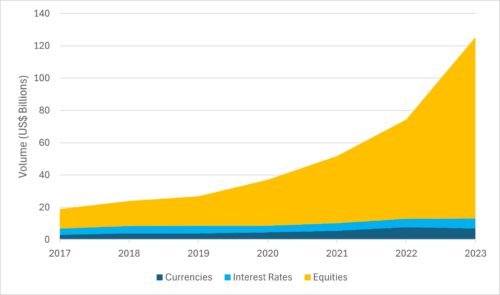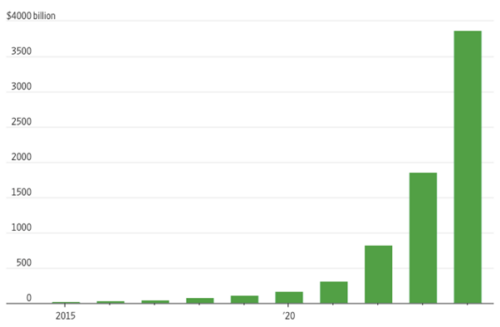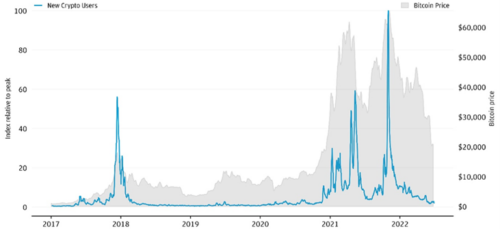

“I can calculate the motions of the heavenly bodies, but not the madness of people” – Isaac Newton in 1720. In 2024, retail investment using complex financial instruments and on undeveloped technologies is at an all-time high with increased access to direct investment enabled by technology. This surge in speculative investment is creating increasing volatility and uncertainty within global financial markets.
Bubbles and market mania are phenomena that have existed for hundreds of years, characterised by overconfidence, herd mentality, and delusions of grandeur. Some notable bubbles include the Dutch Tulip Mania and the Dot-com bubble, underpinned by the greater fool theory which asserts that there is a market participant who is willing to pay a greater price.
The economic climate plays a big part in shaping the confidence of retail investors, with the near prospect of global interest rate cuts propelling equities and cryptocurrencies to new highs. Moreover, the advent of user-friendly trading platforms and mobile applications has lowered barriers to entry, enabling individuals from diverse backgrounds to participate in financial markets with unprecedented ease. Empowered by these tools, a new wave of retail investors has emerged, eager to capitalise on market opportunities and generate returns.
Global derivatives volume (no. of contracts) has consistently trended upwards in the past 5 years, most noticeably in the equities asset class, as reported by the Futures Industry Association (FIA, 2024).
Figure 1: Number of derivatives contracts traded globally.

Source: Futures Industry Association (FIA, 2024)
Surprisingly, India accounted for 78% of options contracts traded worldwide in 2023, with the average Indian retail trader holding options for less than 30 minutes and incurring a ~$2,000 AUD loss over the fiscal year. (WSJ, 2024).
Figure 2: Average daily turnover of Equity Derivatives on the National Stock Exchange of India since 2015

*Note: Financial year ends March 31 in India, 2024 data is YTD; $1 = 82.76 Indian rupees.
Source: Wall Street Journal (WSJ, 2024)
Somewhat similarly, the cryptocurrency space has enjoyed increasing volume and speculative activity as of late, fuelled by Bitcoin’s cyclical price behaviour. However, this cryptocurrency cycle is differentiated in that speculation on lesser-established cryptocurrencies has occurred earlier than expected. Whereas historic cycles involved many traders using profits made from Bitcoin to speculate on ‘altcoins’, this cycle has observed largely concurrent inflows into the two. New and notably outlandish memecoins such as dogwifhat, BONK, and Book of Meme, sit on market caps in the billions of dollars. These projects widely have zero utility, and are propped-up by hype and a fear of missing out.
There are three similar underlying psychological and behavioural aspects common to both penny stocks and meme coins:
Herd-like behaviour seems to play a prominent motivating force in speculative trading. It can be observed in volatile movements in the price of cryptocurrencies such as Bitcoin, particularly where high market confidence and prices draw in new retail investors into speculative markets (JPMorgan Chase, 2022). These often further fuel these bullish market trends. The fear of missing out, also known as FOMO, on lucrative opportunities permeates the market and incites herd-like behaviour, with new investors enamoured by the opportunity for high returns and bounded downside risk (WSJ, 2024). The success of dogwifhat, marked by its meteoric rise to a market cap of 4.5B (AUD), inspired the advent of projects such as catwifhat, epitomising the comical and highly hype-driven nature of purely speculative cryptocurrency projects.
The pervasive reach of social media platforms has brought together communities of like-minded investors, fostering a sense of community and information sharing. Online forums, such as Reddit’s r/wallstreetbets, have emerged as hubs where retail traders converge to exchange ideas, discuss investment strategies, and collectively mobilise capital (Reuters, 2024).
People tend to seek information and media that affirms their own opinions. Speculative investors join communities of others like-minded speculators, creating a concentrated bubble of self-affirming belief and trust in a project. At its peak, such a community will inspire widespread delusion and mania, resulting in groupthink and a death spiral of self-reinforcement.
Figure 3: First Time Crypto Interactors

*Note: New crypto users are counted on a person’s first observed transactions to or from a crypto exchange. Data points are for rolling seven-day periods, and the plot shows new user counts relative to the week with the most new crypto users, seen late 2021.
Source: JP Morgan Chase, Coinbase (JP Morgan Chase, 2024).
As retail investors find financial markets more accessible, this increase in speculative trading results in higher levels of market volatility, and an enhanced price discovery process, among other outcomes (Faster Capital, 2024).
As more investors engage in speculative trading, fuelled by easily accessible online trading platforms and a reduction in information asymmetry, this has resulted in financial assets exhibiting larger trading volumes and higher levels of market volatility. Market volatility is characterised by the fluctuations in prices of financial assets over time and has several underlying benefits. A key benefit of enhanced volatility is improved market liquidity (Axi Trading), as retail investors are able to buy and sell securities at various price levels, giving individuals an opportunity to grow their wealth and improve their financial well-being in the short term. However, the increasing levels of volatility that exist with speculative trading may potentially prove worrisome to some retail investors and ultimately may erode consumer confidence, resulting in lower consumer spending and investment activity, and dampening economic growth.
“Price discovery” is the process by which market participants incorporate consumer sentiment and information into financial assets that lead to its price. Speculative trading has the potential to enhance this process. As more retail investors find financial markets accessible, market participants may be more diverse, and different views and opinions are able to be incorporated into the price of the asset to result in a potentially more accurate valuation.
It is also true that speculative trading can make this process more inefficient. As accessibility to financial markets has increased, so too has the number of investors who are inexperienced or uninformed about market dynamics. This leads to trades made by retail investors that are influenced by emotions and market sentiment, sometimes irrational with disregard for the security’s fundamental value (Science Direct, 2020). As such, the rise of retail speculation may result in prices that do not accurately reflect market information, and as such, a price discovery process that is market inefficient.
Overall, advancements in technology – such as the creation of the smartphone and personal computers, have enabled individuals to access financial markets and deploy capital at a historically unprecedented rate. The fear of missing out coupled with a self-affirming bias due to a widespread prevalence of information sharing in online communities has led to a rapid growth in trading volumes. For example, the share price of GME Resources, an Australian mining company, increased by more than 50% during the Gamestop short squeeze as a result of sharing the same ticker as Gamestop’s NYSE ticker, due to a large base of uninformed retail investors wanting to get in on the “hype” that Gamestop had created (Sydney Morning Herald, 2021). As such, while the growth in retail speculation improves market liquidity and price discovery, it may also lead to concentrated market bubbles and investor overconfidence due to excessive risk-taking, the fear of missing out, and the hope of fast returns.
References
The CAINZ Digest is published by CAINZ, a student society affiliated with the Faculty of Business at the University of Melbourne. Opinions published are not necessarily those of the publishers, printers or editors. CAINZ and the University of Melbourne do not accept any responsibility for the accuracy of information contained in the publication.